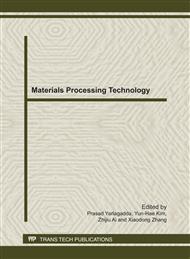[1]
Liu ping. The study of lead-free electronic composite Sn3.8Ag0.7Cu solders for reinforced particles [D]. Tianjin: Tianjin University, 2009.
Google Scholar
[2]
F. Guo, Composite lead-free electronic solders, Journal of Materials and Science: Materials Electronics [J], 2007, 18: 129-45.
Google Scholar
[3]
K. Mohan kumar, A. A.O. Tay, Nano-Particle Reinforced Solders for fine pitch Applications, Electronics Packaging Technology Conference [J], 2004: 455-461.
DOI: 10.1109/eptc.2004.1396651
Google Scholar
[4]
YanYanFu, etal. Creep rupture and enhancement mechanism of Ag particle-enhancement composite solder joints [J].Materials Science and Technology, 2009, 17(3): 418-421.
Google Scholar
[5]
D.C. Lin G.X. Wang,etal. Influence of titanium dioxide nano-powder addition on micro-structural development and hardness of tin–lead solder, Materials Letters, 200357: 3193-3198.
DOI: 10.1016/s0167-577x(03)00023-5
Google Scholar
[6]
X.L. Zhong, M.Gupta, Development of lead-free Sn-0.7Cu/Al2O3 nano-composite solders with superior strength, Journal of Physics D-Applied Physics, 2008, 41(9), 095403.
DOI: 10.1088/0022-3727/41/9/095403
Google Scholar
[7]
Du ChanghHua, Chen Fang. Electronic micro-connection technology and materials [M]. Beijing:China Machine Press, 2007.
Google Scholar
[8]
K.Mohan Kumar,V.Kripesh,L.Shen,etal,Study on the microstructure and mechanical Proper-ties of a novel SWCNT-reinforced solder alloy for ultra-fine pitch applications,Thin Solid Films,2006,504(1-2): 371-378.
DOI: 10.1016/j.tsf.2005.09.072
Google Scholar
[9]
K.M. Kumar, Single-wall carbon nano-tube (SWCNT) functionalized SnAgCu lead-free composite solders, Journal of Alloys Compounds, 2006, 450(1-2): 229-237.
DOI: 10.1016/j.jallcom.2006.10.123
Google Scholar
[10]
S.M.L. Nai,J.Wei,M.Gupta,Improving the performance of lead-free solder reinforced with multi-walled carbon nano tubes, Materials Science and Engineering A 2006 423: 166-169.
DOI: 10.1016/j.msea.2005.10.072
Google Scholar
[11]
Han YongDian.The reliability study of lead-free and Ni-coated carbon nano-tubes reinforced Sn-Ag-Cu solder [D]. Tianjin: Tianjin University, 2009.
Google Scholar
[12]
W.M. Xiao, Y.W. Shi, Y.P. Lei, etal. In situ scanning electron microscopy observation of tensile deformation in Sn-Ag-Cu alloys containing rare-earth elements, Journal of Electronic Materials,2008,37(11): 1751~1755.
DOI: 10.1007/s11664-008-0532-2
Google Scholar
[13]
W.X. Dong Y.W. Shi Z.D. Xia,et al. Effects of trace amounts of rare earth additions on microstructure and properties of Sn-Bi-based solder alloy,Journal of Electronic Materials,2008,37(7): 982~991.
DOI: 10.1007/s11664-008-0458-8
Google Scholar
[14]
A. Lee, K. Nora. Subramanian. Development of nano-composite lead-free electronic solders, Journal of Electronic Materials, 2005, (34): 1399-1407.
DOI: 10.1007/s11664-005-0197-z
Google Scholar
[15]
Tai Feng, Guo Fu, Liu Bin, etal. Properties of new nano-structured particles reinforced lead-free composite solders [J]. Acta Materiae Compositae Sinica.
Google Scholar


